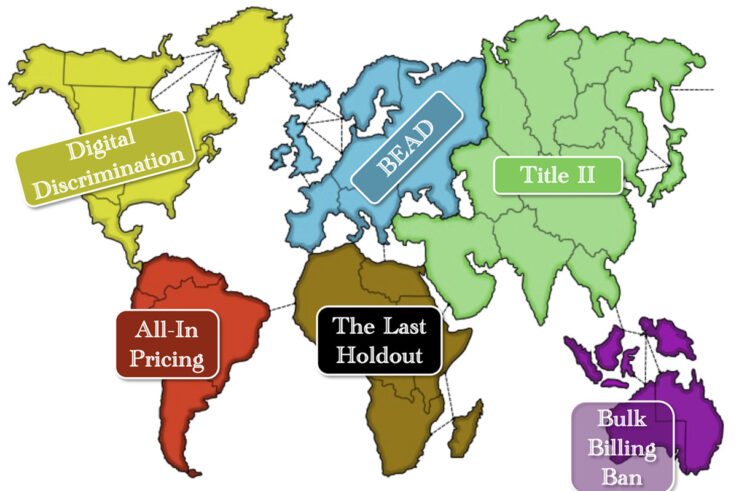While Intel Corporation nears its settlement deadline with the Federal Trade Commission, it received good news from a federal district court in Delaware evaluating the evidence of alleged consumer harm from the discounts Intel offers to buyers. It is also very important to note that this pass from a US court applying standards of consumer harm embedded in US Section 2 case law — that is, actual harm to consumers and the competitive process rather than allowing harm to competitors to serve as a sufficient condition for proof of the former — is the first to evaluate the consumer welfare effects of Intel’s conduct from this more rigorous perspective. One has to wonder whether this ruling will shift settlement negotiations in favor of Intel. Its true that the FTC can use Section 5 to evade this Section 2 competitive effects analysis. But not without eventually testing their interpretation of Section 5 in front of a panel at the D.C. Circuit.
From today’s WSJ:
Intel Corp. won a key ruling in a suit against the company on behalf of computer buyers, which found no evidence that consumers have been hurt by the company’s discounting practices in the market for computer chips. …
The case had proceeded in parallel with a private antitrust suit brought in June 2005 by Advanced Micro Devices Inc., which Intel agreed to settle in November along with a $1.25 billion payment to AMD. Both cases alleged that Intel used improper discounts and other tactics to deter computer makers from buying microprocessor chips from AMD, with the proposed class-action case focusing on alleged harm to consumers from Intel’s behavior.
Intel’s tactics have also been challenged by antitrust agencies on three continents, including a suit by the U.S. Federal Trade Commission that is in settlement negotiations. Throughout the process, Intel has denied wrongdoing and argued that its discounting practices represented a lawful form of competition that has helped bring PC prices down.
Special Master Vincent Poppiti appeared to give support to that argument. In a 112-page opinion, he wrote that PC makers had discretion about how to use Intel discounts. In some cases, he wrote, they passed the benefits on to consumers in the form of lower prices—undercutting the idea that all members of the proposed class of consumers suffered a “common impact” from Intel’s action. Mr. Poppiti based his conclusions on what he called the “unreliable analyses” of an expert witness for the plaintiffs, who argued that consumers had been overcharged as a result of Intel’s tactics.
I’ve not read Special Master Poppiti’s analysis. However, as readers of TOTM will know, I’ve been very critical of the Federal Trade Commission’s Complaint against Intel primarily on two grounds: (1) the wobbly intellectual underpinnings of the Commission’s attempt to expand its FTC Act Section 5 authority to evade (see also here) the more stringent monopolization standards under Section 2 of the Sherman Act, and (2) that the economic merits of the Commission’s anticompetitive theory are questionable when laid against the available data. Poppiti’s analysis, as reported, appears to be consistent with the second line of attack.
For more analysis of both, please see, An Antitrust Analysis of the Federal Trade Commission’s Complaint Against Intel, combines these two themes. The paper will be released as the first installment of the International Center for Law and Economics Antitrust & Competition Policy White Paper Series. The paper considers the economic merits of the Commission’s anticompetitive theory, evaluates the testable implications of that theory against the available data, and offers a critique of the Commission’s proffered justifications for the Section 5 allegations.
Here is the abstract:
The Federal Trade Commission’s recent complaint targets the Intel Corporation for antitrust scrutiny under Section 5 of the Federal Trade Commission Act and Section 2 of the Sherman Act. The Commission alleges that, through the use of loyalty discounts offered to microprocessor purchasers, Intel unlawfully excluded rivals and harmed consumers in the microprocessor and graphics processor markets. This article analyzes the Commission’s claims. The Commission’s reliance on Section 5 should be viewed with suspicion because it allows the Commission to evade the more stringent standards of proof that have been emerged in the Supreme Court’s Section 2 jurisprudence. Furthermore, the Commission’s actions surrounding its prosecution of Intel reflect an adversarial attitude that undermines the Commission’s stated comparative advantages over private litigants. Moreover, the Commission’s allegations form a weak case when evaluated under the conventional Section 2 standard. Unlike many Section 2 cases alleging speculative future consumer harm, the disputed conduct in this case has been in the marketplace for nearly a decade, and its competitive footprint is readily observable. The available data do not support the Commission’s theory that Intel’s behavior harmed consumers. To the contrary, it is almost certain that Intel’s distribution contracts led to tangible, demonstrable consumer welfare gains in the form of lower prices. Accordingly, the Commission’s complaint against Intel threatens to harm consumers directly in the computer industry as well as indirectly by undermining the stability and certainly which longstanding Section 2 jurisprudence has afforded the business community by requiring the plaintiffs offer rigorous proof of competitive harm.
Readers might also be interested in TOTM guest-blogger Dan Crane and Herbert Hovenkamp on the FTC’s case against Intel.




